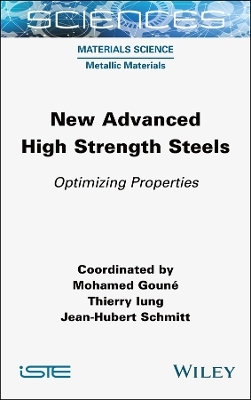
New Advanced High Strength Steels
Iste Ltd (Verlag)
978-1-78945-122-1 (ISBN)
The development of ultra-high strength steels requires a search for new trade-offs between these properties in order to optimize the final microstructure. New Advanced High Strength Steels analyzes the interactions between tensile mechanical properties and properties such as work hardening, anisotropy, resistance to rupture, fatigue life, corrosion resistance, crashworthiness, edge retention, hydrogen resistance and weldability. It also examines the links between the microstructural parameters of high-strength steels and the properties mentioned above. It highlights the metallurgical developments that have been necessary for the emergence of these new generations of steels.
The book concludes with a look ahead to future developments in ultra-high strength steels.
Mohamed Gouné is a university professor at the University of Bordeaux, France, a researcher at the ICMCB and a specialist in the genesis of nano/microstructures in metal alloys. Thierry Iung is a metallurgy expert and head of metallurgy research for products and processes at ArcelorMittal, Maizières-lès-Metz. Jean-Hubert Schmitt is professor emeritus at Centrale Supélec, France. He is a specialist in the mechanical behavior of metallic alloys in relation to their microstructure.
Foreword xiii
David EMBURY
Introduction xvii
Mohamed GOUNÉ, Thierry IUNG and Jean-Hubert SCHMITT
Chapter 1 Strain Hardening and Tensile Properties 1
Mohamed GOUNÉ and Olivier BOUAZIZ
1.1 Introductory remarks 1
1.2 Stress/strain curve: macroscopic quantities 2
1.3 Behavior of a single-phase structure: microscopic approach 3
1.4 Strain hardening and mechanical behavior of precipitation hardened micro-alloyed steels 7
1.5 Strain hardening and mechanical behavior of martensitic steels 19
1.6 Austenitic steels Fe-0.6C-22Mn with TWIP effect 23
1.7 Multiphase quenching and partitioning steels 28
1.8 Conclusion 38
1.9 References 39
Chapter 2 Anisotropy and Mechanical Properties 43
Hélène RÉGLÉ and Brigitte BACROIX
2.1 Challenges 44
2.2 Textural anisotropy and mechanical properties 46
2.3 Conclusion 61
2.4 Calculation details 62
2.5 References 67
Chapter 3 Compromise between Strength and Fracture Resistance 71
Anne-Françoise GOURGUES-LORENZON and Thierry IUNG
3.1 Introduction 71
3.2 Methods for measuring the resistance to damage and fracture 71
3.3 Physical mechanisms and microstructural control of damage and fracture 80
3.4 Examples of application 89
3.5 Conclusion and outlook 99
3.6 References 100
Chapter 4 Compromise between Tensile and Fatigue Strength 103
Véronique FAVIER, André GALTIER, Rémi MUNIER and Bastien WEBER
4.1 Toughness: the main cause of part failure in service 103
4.2 Fatigue: from crack initiation to failure 104
4.3 How to improve fatigue life through metallurgy? 112
4.4 Increasing role of defects in high strength steels 123
4.5 Specific treatments for fatigue performance 126
4.6 Conclusion 128
4.7 References 129
Chapter 5 High Strength Steels and Coatings 133
Marie-Laurence GIORGI and Jean-Michel MATAIGNE
5.1 Introduction 133
5.2 The continuous galvanizing process 134
5.3 Selective oxidation during continuous annealing 143
5.4 Coatings on high-strength steels 149
5.5 Conclusion 160
5.6 References 161
Chapter 6 Corrosion Resistant Steels with High Mechanical Properties 167
Franck TANCRET, Christine BLANC and Vincent VIGNAL
6.1 Introduction 167
6.2 General principles of corrosion/oxidation and corrosion/oxidation resistance 168
6.3 Wet corrosion resistant and high strength steels 169
6.4 Alloys resistant to hot oxidation and creep 184
6.5 Conclusion 193
6.6 References 194
Chapter 7 Crashworthiness by Steels 197
Dominique CORNETTE, Pascal DIETSCH, Kevin TIHAY and Sébastien ALLAIN
7.1 Introduction and industrial issues 197
7.2 The tests in force, or how to pass from the behavior of the complete vehicle to the behavior of the material 198
7.3 Parameters influencing the material during the manufacturing process and the behavior in service 214
7.4 Adequacy between material properties and crash behavior according to the different evaluation criteria 220
7.5 Conclusion 230
7.6 References 230
Chapter 8 Cut Edge Behavior 233
Stéphane GODET, Ève-Line CADOTTE and Astrid PERLADE
8.1 Introduction/problem analysis 233
8.2 Cutting processes and characteristics of the cut edge 234
8.3 Behavior of the cut edge 240
8.4 Conclusion 260
8.5 References 260
Chapter 9 The Relationship between Mechanical Strength and Hydrogen Embrittlement 263
Xavier FEAUGAS and Colin SCOTT
9.1 Introduction 263
9.2 How to identify and characterize HE 264
9.3 Solubility and (apparent) diffusion coefficients of hydrogen in steels 268
9.4 Case study: embrittlement of fastener steels 276
9.5 Case study: HE of thin sheets 284
9.6 Research and perspectives 293
9.7 References 295
Chapter 10 Weldability of High Strength Steels 303
Thomas DUPUY, Jessy HAOUAS and Laurent JUBIN
10.1 Introduction 303
10.2 Weldability issues 307
10.3 Solutions for a good weldability of high-strength steels 324
10.4 References 330
Appendix: A Brief Review of Steel Metallurgy 333
Thierry IUNG and Jean-Hubert SCHMITT
Postface: What's Next for Ultra-high Strength Steels? 373
François MUDRY
List of Authors 381
Index 385
| Erscheinungsdatum | 19.12.2023 |
|---|---|
| Verlagsort | London |
| Sprache | englisch |
| Gewicht | 857 g |
| Themenwelt | Technik ► Maschinenbau |
| ISBN-10 | 1-78945-122-1 / 1789451221 |
| ISBN-13 | 978-1-78945-122-1 / 9781789451221 |
| Zustand | Neuware |
| Haben Sie eine Frage zum Produkt? |
aus dem Bereich


